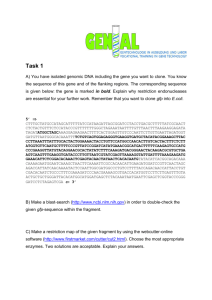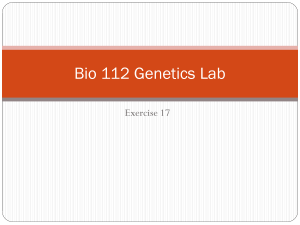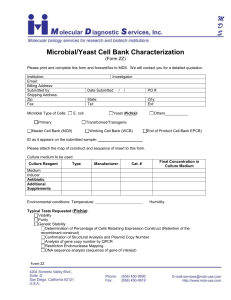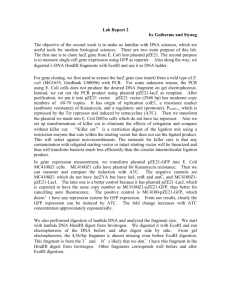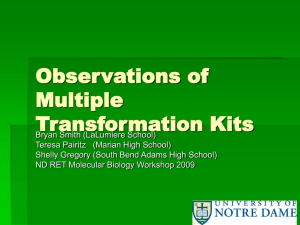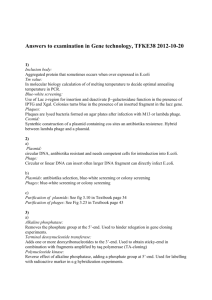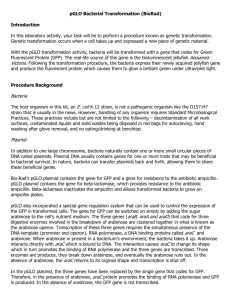GFP Introduction Powerpoint Presentation - mvhs
advertisement
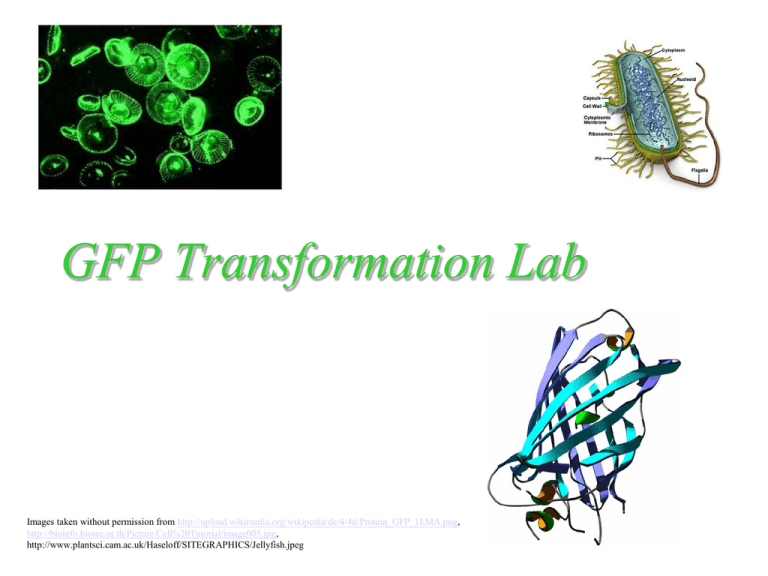
GFP Transformation Lab Images taken without permission from http://upload.wikimedia.org/wikipedia/de/4/4d/Protein_GFP_1EMA.png, http://bioinfo.biotec.or.th/Picture/Cell%20Tutorial/image005.jpg, http://www.plantsci.cam.ac.uk/Haseloff/SITEGRAPHICS/Jellyfish.jpeg Overall Goal of Lab Experiment • Use genetic engineering techniques to insert the GFP gene into E. coli Plasmid containing gene of interest Protein we want to produce GFP (Green Fluorescent Protein) • Naturally produced in Jellyfish– Aequorea victoria • Discovered in 1960’s • Source of bioluminescence when exposed to UV light Img Src: http://icbxs.ethz.ch/members/leu/jellyfish.gif , http://www.plantsci.cam.ac.uk/Haseloff/SITEGRAPHICS/Jellyfish.jpeg Structure of the GFP Protein Img Src: http://wwwchem.leidenuniv.nl/metprot/armand/images/029l.jpg Why Is Bioluminescence Useful in Nature? • Attract Mates • See Food • Defense Img Src: http://www.sio.ucsd.edu/explorations/biolum/images/Latz_p1.jpg Img Src: http://www.biolum.org/ How GFP is being used • Tag Cells (to detect specific cells) • Act as a reporter gene - link it to another gene to show if it is expressed • Expressed in entire animals Img Src: http://www.bio.umass.edu/microscopy/images/gfp.jpg Img Src: http://www.mshri.on.ca/nagy/graphics/GFP%20mic e.jpg Img Src: http://www.antville.org/img/pop/gfp.jpg Img Src: http://www.computerra.ru/pubimages/73944.jpg Nobel Prize 2008 • In 2008, 3 scientists were awarded the 2008 Nobel Prize in Chemistry for their work on GFP pGLO plasmid • The plasmid we’re using in the lab • 3 genes of interest: – GFP gene • Codes for the GFP protein – Bla gene • Codes for the enzyme b-lactamase • b-lactamase destroys the antibiotic ampicillin – araC gene • Codes for the araC protein Arabinose operon • The arabinose operon in bacteria consists of the following: Usually, the araC protein binds to the arabinose operon operator prevents transcription When arabinose is present, it binds to the araC protein -> can’t bind to operator RNA polymerase can continue Modified arabinose operon • Scientists modified the arabinose operon in the pGLO plasmid to express the GFP gene. araC protein binds to the operator prevents transcription When arabinose binds to araC it can no longer bind to operator GFP gene is transcribed and translated Selecting for Transformed Cells • Selection = process to determine which E. coli successfully took in a plasmid • Achieved through the use of selectable markers • Selectable markers = traits that help identify a cell with the plasmid in it (compared to one without it) • In our experiment, the bla gene will serve as the selectable marker Images taken without permission from http://www.antibioresistance.be/Gifs_Ant/blue2.gif and http://www.antibioticos.it/images/formule%20chimiche/ampicillin.gif Review Question… • What protein does the bla gene code for? – b-lactamase protein • What does this protein do? – Digests the antibiotic ampicillin • How could the bla gene serve as a selectable marker? – Only cells with the pGLO plasmid will make blactamase are resistant to ampicillin Growing E. coli • Bacteria is grown on LB agar – LB agar contains all of the nutrients and amino acids E. coli need to survive – Other substances such as antibiotics can also be added to the LB agar. Selection Process grown on plain LB agar E. coli cells that have gone through the tranformation process grown on LB agar with ampicillin All E. coli grow (transformed and untransformed) Only transformed cells grow Controls • Grow E. coli without plasmid (- DNA) on plain LB agar – Make sure E. coli can grow • Grow E. coli without plasmid (- DNA) on LB/amp – Make sure E. coli aren’t already resistant to ampicillin • Grow E. coli with plasmid (+ DNA) on LB/amp – Make sure transformation didn’t kill E. coli Transformation Efficiency • Quantitative measurement of how well the transformation worked. • Measures the number of bacteria transformed by 1 mg of plasmid DNA. = total # of cells growing amount of DNA spread on plate
